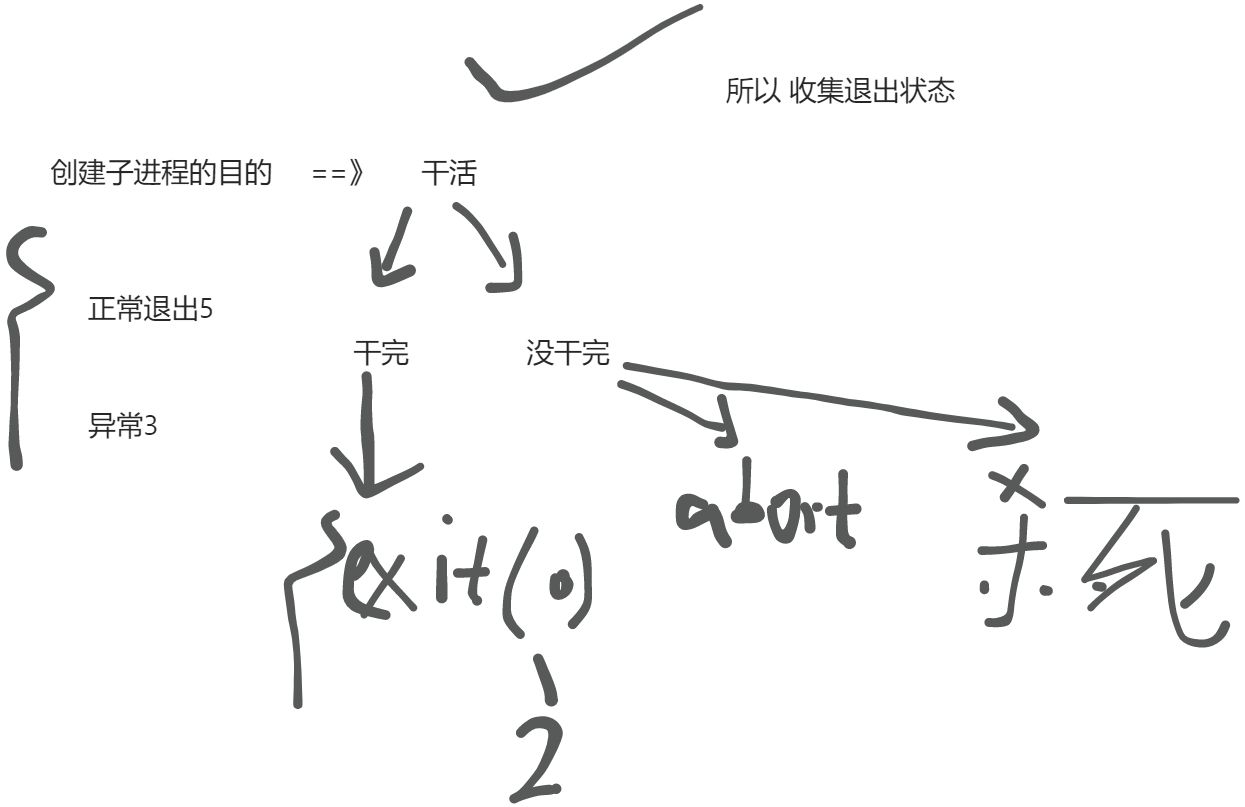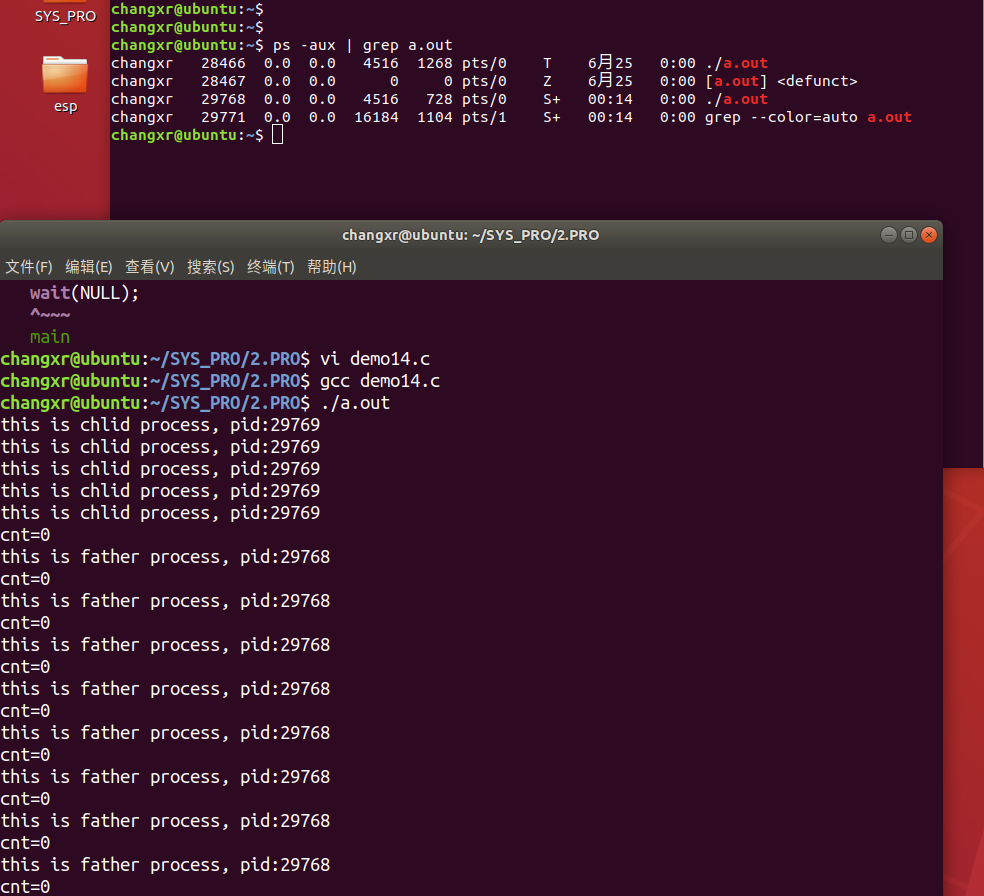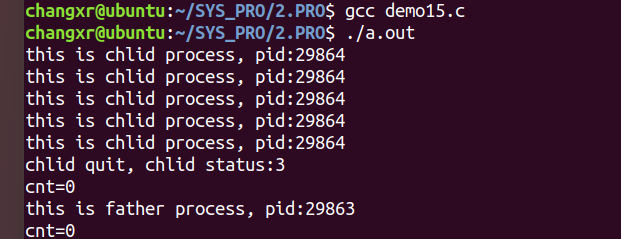文章目录
- 一、进程退出
- 1.1、进程正常退出方式
- 1.2、异常退出
- 二、父进程等待子进程退出(一)
- 2.1、为什么要等待子进程退出
- 2.2、(1)父进程等待子进程退出并收集子进程的退出状态
- 如何等待
- wstatus空
- wstatus非空
- 2.3、(2)子进程退出状态不被收集,变成僵尸进程(僵死进程)。
- vfork没有使用wait,退出状态不被收集,子进程变成僵尸进程
- fork没有使用wait,退出状态不被收集,子进程变成僵尸进程
- 三、父进程等待子进程退出(二)
- 3.1、相关函数
- 阻塞等待
- 非阻塞等待
- 3.2、孤儿进程(面s)
一、进程退出
vfork保证子进程先运行,当子进程退出后,父进程才运行。
1.1、进程正常退出方式
共5种退出方式
- main函数调用return
- 进程调用exit(),标准c库
- 进程调用_exit()或者_Exit(),属于系统调用
补充
- 进程最后一个线程返回
- 最后一个线程调用pthread_exit
1.2、异常退出
- 主动调用abort(),放弃当前进程
- 当进程收到某些信号时,如ctrl+C【ctrl+Z???挂起】
- 最后一个进程对取消(cancellation)请求做出相应
不管进程如何终止,最后都会执行内核中同一段代码。这段代码为响应进程关闭素有打开的描述符,释放它所使用的存储器。
对上述任意一种终止情形,我们都希望终止进程能够通知其父进程它是如何终止的。对于三个终止函数(exit、_exit、_Exit),实现这一点的方法是,将其退出状态传递(exit status)作为参数传递给函数。
在异常终止情况下,内核(不是进程本身)产生一个指示其异常终止原因的一个状态(termination status)。在任意一种情况下,该终止进程的父进程都能调用wait或waitpid函数取得其终止状态。
那么收集退出状态无非就是给exit函数传递一个值。

建议使用exit,是对_exit或_Exit的封装,会对进程的缓冲区做些处理,而_exit或_Exit系统调用是直接退出。
#include <sys/types.h>
#include <unistd.h>
#include <stdio.h>
#include <stdlib.h>int main()
{pid_t pid;int cnt = 0;pid = vfork();if(pid > 0){while(1){printf("cnt=%d\n", cnt);printf("this is father process, pid:%d\n",getpid());sleep(1);}}else if(pid == 0){while(1){printf("this is chlid process, pid:%d\n",getpid());sleep(1);cnt++;if(cnt == 3){_Exit(0);//break;}}}return 0;
}二、父进程等待子进程退出(一)
2.1、为什么要等待子进程退出
问:创建子进程的目的是什么?
创建子进程的目的是为了让子进程干活,那么子进程不一定能把交给它的活顺利都做完。所以我们比较关心子进程干没干完活,干的怎么样。所以我们要等待子进程的退出,并且收集退出的状态。
我不仅要等待子进程的退出,而且还要检测你这个活干的怎么样。 你正常退出,你活干到什么程度,根据exit的退出码的不同进程判断。你没干完是异常退出,你是不想干了还是其它原因ctrl+C了等等。这是父进程为什么要等待子进程的退出的原因。
2.2、(1)父进程等待子进程退出并收集子进程的退出状态
调用wait函数,解析返回状态码。子进程调用exit返回状态码。
调用wait可以防止子进程变成僵尸进程。
如何等待
使用wait函数
函数参数是一个地址
wstatus参数:是一个整型数指针
wstatus非空:子进程退出状态放在它所指向的地址中。
wstatus空:不关心退出状态。
wstatus空
父进程中使用了wait函数,就不会出现子进程变成僵尸进程的情况。
#include <sys/types.h>
#include <sys/wait.h>
#include <unistd.h>
#include <stdio.h>
#include <stdlib.h>int main()
{pid_t pid;int cnt = 0;pid = fork();if(pid > 0){wait(NULL);while(1){printf("cnt=%d\n", cnt);printf("this is father process, pid:%d\n",getpid());sleep(1);}}else if(pid == 0){while(1){printf("this is chlid process, pid:%d\n",getpid());sleep(1);cnt++;if(cnt == 5){exit(0);}}}return 0;
}wstatus非空
非空:检查退出状态,存在status里面 
#include <sys/types.h>
#include <sys/wait.h>
#include <unistd.h>
#include <stdio.h>
#include <stdlib.h>int main()
{pid_t pid;int cnt = 0;int status = 10;pid = fork();if(pid > 0){wait(&status);printf("chlid quit, chlid status:%d\n", WEXITSTATUS(status));while(1){printf("cnt=%d\n", cnt);printf("this is father process, pid:%d\n",getpid());sleep(1);}}else if(pid == 0){while(1){printf("this is chlid process, pid:%d\n",getpid());sleep(1);cnt++;if(cnt == 5){exit(3);}}}return 0;
}2.3、(2)子进程退出状态不被收集,变成僵尸进程(僵死进程)。
vfork没有使用wait,退出状态不被收集,子进程变成僵尸进程
没有使用wait,退出状态不被收集
#include <sys/types.h>
#include <unistd.h>
#include <stdio.h>
#include <stdlib.h>int main()
{pid_t pid;int cnt = 0;pid = vfork();if(pid > 0)//父进程{while(1){printf("cnt=%d\n", cnt);printf("this is father process, pid:%d\n",getpid());sleep(1);}}else if(pid == 0){while(1){printf("this is chlid process, pid:%d\n",getpid());sleep(1);cnt++;if(cnt == 3){exit(0);//break;}}}return 0;
}
使用ps查看进程
S+ 是正在运行的状态
Z+ 是僵尸进程 zombie
fork没有使用wait,退出状态不被收集,子进程变成僵尸进程
fork 父进程没有wait
同样,子进程执行结束,父进程没收集其退出状态,变为了僵尸进程
#include <sys/types.h>
#include <unistd.h>
#include <stdio.h>
#include <stdlib.h>int main()
{pid_t pid;int cnt = 0;pid = fork();if(pid > 0){while(1){printf("cnt=%d\n", cnt);printf("this is father process, pid:%d\n",getpid());sleep(1);}}else if(pid == 0){while(1){printf("this is chlid process, pid:%d\n",getpid());sleep(1);cnt++;if(cnt == 5){exit(0);}}}return 0;
}三、父进程等待子进程退出(二)
3.1、相关函数

- 如果其所有子进程都在执行,则阻塞
- 如果一个子进程已终止,正等待父进程获取其终止状态,则取得该子进程的终止状态立即返回
- 如果它没有任何子进程,则立即出错返回
对于waitpid函数中几个参数解释如下:
- pid == -1 等待任意子进程。就这一方面而言,waitpid与wait等效。
- pid > 0 等待其进程ID与pid相等的子进程。
- pid == 0 等待其组ID等于调用进程组ID的任一子进程。
- pid < -1 等待其组ID等于pid绝对值的任一子进程。
status参数:是一个整型数指针
非空:子进程退出状态放在它所指向的地址中。
空:不关心退出状态
阻塞等待
阻塞等待不会出现僵尸进程情况
#include <sys/types.h>
#include <sys/wait.h>
#include <unistd.h>
#include <stdio.h>
#include <stdlib.h>int main()
{pid_t pid;int cnt = 0;int status = 10;pid = fork();if(pid > 0){wait(&status);//阻塞等待printf("chlid quit, chlid status:%d\n", WEXITSTATUS(status));while(1){printf("cnt=%d\n", cnt);printf("this is father process, pid:%d\n",getpid());sleep(1);}}else if(pid == 0){while(1){printf("this is chlid process, pid:%d\n",getpid());sleep(1);cnt++;if(cnt == 3){exit(3);}}}return 0;
}
非阻塞等待
非阻塞(se)等待,子进程也会变成僵尸进程(实验证明)。而且waitpid马上打印,好像不关心子进程,所以使用不多。一般使用wait。
#include <sys/types.h>
#include <sys/wait.h>
#include <unistd.h>
#include <stdio.h>
#include <stdlib.h>int main()
{pid_t pid;int cnt = 0;int status = 10;pid = fork();if(pid > 0){//wait(&status);waitpid(pid, &status, WNOHANG);//非阻塞等待printf("chlid quit, chlid status:%d\n", WEXITSTATUS(status));while(1){printf("cnt=%d\n", cnt);printf("this is father process, pid:%d\n",getpid());sleep(1);}}else if(pid == 0){while(1){printf("this is chlid process, pid:%d\n",getpid());sleep(1);cnt++;if(cnt == 3){exit(3);}}}return 0;
}3.2、孤儿进程(面s)
父进程不等待子进程退出,在子进程结束之前就结束了自己的“生命”,此时子进程叫做孤儿进程。
Linux避免系统存在过多孤儿进程,init进程收留孤儿进程,变成孤儿进程的父进程。
init进程ID为1
实验验证:
#include <sys/types.h>
#include <sys/wait.h>
#include <unistd.h>
#include <stdio.h>
#include <stdlib.h>int main()
{pid_t pid;int cnt = 0;int status = 10;pid = fork();if(pid > 0){printf("this is father process, pid:%d\n",getpid());}else if(pid == 0){while(1){printf("chlid pid:%d, my father pid:%d\n",getpid(), getppid());sleep(1);cnt++;if(cnt == 5){exit(3);}}}return 0;
}

这里父进程退出后,新的父进程的进程id为1468而不是1。
是因为:这里是在图形界面伪终端运行的,shell其实是init进程的一个子进程,故孤儿进程其实是被shell所收养
在字符化界面运行时,ppid就是1了。


)
















